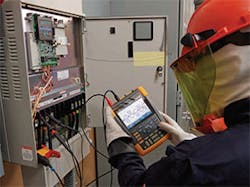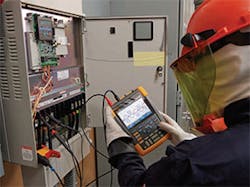While we hear a lot about the skills gap and the industrial internet of things (IIoT), often overlooked is the fact that testing and troubleshooting tools are evolving to improve maintenance workers’ efficiency and productivity. This trend is poised to help bridge the skills and experience gap and facilitate the onboarding and training of younger workers who are super-tech-savvy. Today’s testing tools are sophisticated yet easy to use and can enhance an IIoT strategy with automatic upload of data to the cloud.
With embedded algorithms, “wizards,” and step-by-step instructions, workflows that once required specialized knowledge now can be performed by a more-junior technician.
It’s a fact of industrial life that equipment degrades over time, gets out of calibration, and breaks down, keeping maintenance teams busy. Whatever terms a plant uses to describe its asset management objectives – reliability, predictive maintenance, or proactive maintenance – the goal is to stay ahead of the failure curve and keep equipment and the plant running at peak performance.
Steps along the reliability journey
Many maintenance managers find a more-predictive approach to be a good idea, but it can be difficult to build the necessary infrastructure to make it work given manpower and resource constraints. One of the ways in which test and measurement companies are addressing these issues is by building intelligence into test tools and software so that said tools don’t take special training or years of experience to productively operate. This technology ranges from vibration and thermal sensors to automated 4-20 mA valve calibrators and software with built-in predictive maintenance routes.
Building automation into the tools isn’t about making them more complex for the user. While they are internally high-tech, the goal is to make the tools easier to use than ever before and open expert work to a greater number of workers.
Take, for example, an automated signature test built into a valve calibrator. At the push of a button, the tool runs through all required tests of the valve and the control loop and produces a readout on the valve condition – whether it’s good, marginal, or bad – and documents the results. The automated test saves time and can help a plant avoid taking a process down to pull a valve that might be operating within limits.
New vibration solutions
Consider that for decades only two solutions were generally available to determine the condition of rotating machinery in the plant: a high-end and high-cost vibration analyzer or a low-end vibration pen. The high-end analyzer shows detailed waveform data that requires experienced interpretation, while the low-end vibration pen is easy to use but provides only a simple number with not much information.
Recently, however, several new options have emerged that fit between the analyzer and the vibration pen. These include small vibration sensors that can be affixed to rotating machines to continuously monitors assets as well as small handheld vibration meters that can quickly screen for problems and give a status of equipment.
The idea is that you can send out a lesser-skilled technician to run an automated test, screen the machine, or take a measurement. By providing a basic equipment health assessment, these tools again let a plant avoid interrupting a process or a manufacturing line to pull a piece of equipment offline. If the results of the health assessment are bad, you can bring in a specialist.
A sample of intelligent test tools:
- A 4-20 mA loop valve calibrator with powerful processor and algorithms built in to ease the testing of a HART smart control valve.
- A handheld automatic pressure calibrator with a built-in pump that compensates for minor leaks and connection issues. It improves calibration integrity and automatically documents for compliance and verification.
- Sensors – vibration, infrared, electrical – that automatically upload data to the cloud for troubleshooting and to help predict machine failure.
- Motor analyzers that, when attached to the power supply, can test torque and speed and compare this data against manufacturer spec data without mechanical sensors.
- Motor drive analyzers, which are easy-to-use oscilloscopes with step-by-step instructions and diagrams that lead a technician through test procedures and automatically set up to perform a test.
Smart tools can help bridge the skills gap and help plants realize the potential of the IIoT, and they often come in familiar forms that technicians are comfortable using and manipulating. The tools save time and offer never-before-possible ease of use as well as diagnostic capabilities. They also provide a path for lesser-skilled technicians to gain experience and improve skills over time to advance into more diagnostic and troubleshooting roles.
This article is part of our monthly Automation Zone column. Read more from our monthly Automation Zone series.
Norbert Hanigovszki, an R&D project director at Danfoss Drives who helped develop a new motor drive analyzer with built-in preconfigured essential tests with graphical walk-throughs, offers: “It’s sort of like a wizard. It tells you what you want to measure. If you want to measure, for example, the voltage of the output of the drive, it will preset the instrument in order to measure that particular spot …. The instrument is already set to perform the measurement, so the time scale will also be correct for the selected type of measurement. That is helpful for the non-motor-drive specialists.”
The growing skills gap in industry is a byproduct of the trend of experienced industrial workers retiring or nearing retirement. Companies are challenged to replace these individuals with equally skilled workers. Newer maintenance crews can have a variety of skill sets, including electrical and mechanical skills as well as computer savvy – as in, for example, the know-how to set up criticality lists in CMMS systems, build dashboards, install sensors, or perform routine screenings.
The IIoT promises a smarter factory with robots, controls, and predictive technologies connected to the internet. Many of the newest tools are wireless and can upload data automatically to the cloud or provide easy connections.
Today’s smarter tools don’t replace experts, but they can make the experts more efficient and enable them to provide detailed reporting of test data. They allow maintenance managers to bring in the big guns for only the most complex or critical machines. The new tools allow the maintenance group to cover more ground with the same resources – with documentation that can follow shift changes and be correlated with other data and trended over time. Generalist technicians can be used to screen machines, upload data, or set sensors at critical points, and in so doing they can begin to develop the skill sets needed to become experts in the future.
Indeed, intelligence built into test instruments could prove to be an answer for many maintenance teams looking to expand their capabilities or even for skilled specialists who want to save time in the plant.


